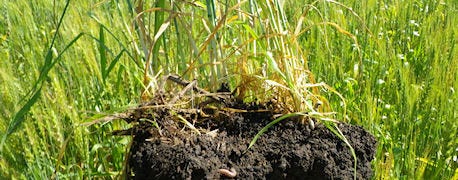September 12, 2013

South Dakota's surface soils are apparently becoming more acid, says Ron Gelderman, South Dakota State University Extension soils specialist.
The percent of soil samples received at the SDSU Soil Testing Laboratory in the five year period from 1985-1989 that were pH 5.5 and below was 0.3%, whereas for the period of 2006-2010 the level was at 2.7% -- a nine fold increase in acid soils for the 20 year period.
Research at SDSU has shown response to lime additions for both corn and soybean when pH drops below 5.5 on some soils, Gelderman says. A buffer test should be done to estimate which soils will respond and to estimate lime need for potentially responsive soils.

Long term fertilizing and/or leaching has apparently lowered soil pH in South Dakota.
Soil pH is one of the most basic of soil measurements and one of the most telling for soil productivity, Gelderman says. Soil pH can directly influence plant and soil microbial growth. Soil pH can also influence soil nutrient availability, as well as indicate the presence of free lime and an excess of some ions such as sodium and aluminum.
Soil pH is a measurement of active soil acidity which is the concentration of hydrogen ions in the soil solution. Soil solution acidity is usually measured with pH electrodes. Soil solution pH is also related to the reserve acidity which is hydrogen ions attached to clay and organic matter. Reserve acidity is measured with a buffer pH in a buffer solution.
A soil pH of less than 7.0 is considered acid and those above 7.0 are alkaline. Most agricultural crops thrive between pH 6.0 and 7.5 and many grow well from pH 5.5 thru 8.0. Fortunately, over 70% of South Dakota's agricultural soils are in the range of pH 6.0 – 7.5 and almost 95% between pH 5.5 and 8.0 range. Most macro nutrients are highly available throughout the 6.0 – 7.5 pH range. Most micronutrients are more available when pH is below 6.5.
Long-term leaching or loss of basic cations such as calcium, magnesium, potassium and sodium have decreased soil pH in the higher rainfalls of eastern South Dakota compared to the western part of the state. Cultivation has speeded up this loss and the loss of organic matter from the native prairie soils has also decreased surface soil pH. Organic matter mineralization or loss provides both organic and inorganic acids that can lower pH. Removal of basic cations with crop grains and residues will also lower soil pH over time. Loss of cations is 5 to 7 times more when also removing stover compared to grain removal only. Lime, some irrigation waters and sometimes manure additions can supply basic cations and raise or maintain soil pH levels.
Fertilization with most of our common nitrogen, phosphorus and sulfur fertilizers will also lower soil pH. Most of these fertilizers contain ammonium which, when biologically transformed to nitrate-N, release hydrogen ions that decrease soil pH. Some of this acidity is neutralized by plant uptake of nitrate in which the plant roots exude basic anions. Since the 1950's, when fertilizer use began to increase in the state, this process has probably decreased soil pH more than any other. For example, a long term (20 year) nitrogen rate study for corn in a corn-soybean rotation near Beresford SD, shows current surface soil pH levels of 6.6, 6.4, 5.9 and 5.2 for the nitrogen rates of 0, 100, 200, and 400 lb./a, respectively.
Source: SDSU
You May Also Like




